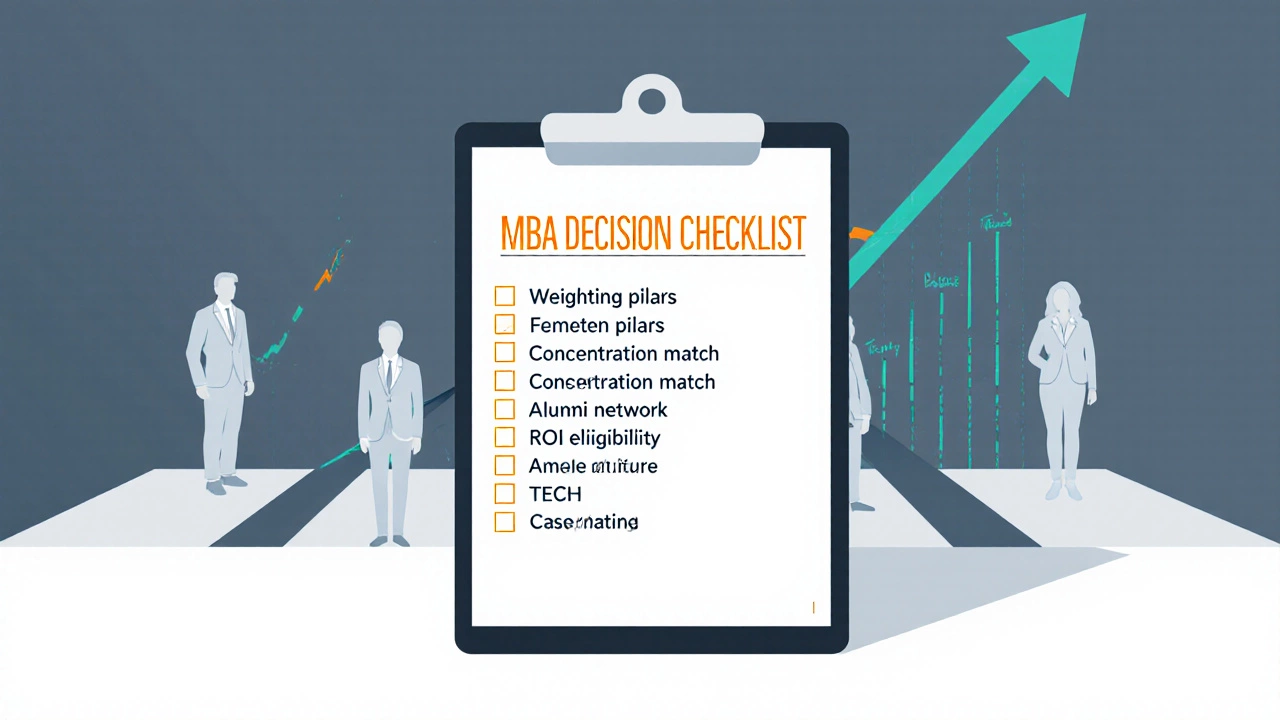MBA Program ROI Calculator
Calculate Your MBA Return on Investment
Determine if an MBA program offers a favorable return on your investment based on salary, costs, and industry placement.
Your ROI Calculation
Expected salary:
Total cost:
Time to recoup:
Choosing the best MBA program feels like a high‑stakes puzzle: you want prestige, career boost, and a good return on investment, but every school boasts something different. This guide breaks down the most important factors, lines up the top global programs, and gives you a practical checklist so you can decide which MBA fits your goals and budget.
Key Takeaways
- Rankings matter, but fit, specialization, and network are often more decisive.
- Four key evaluation criteria: reputation, curriculum focus, post‑MBA salary uplift, and total cost.
- Harvard, Stanford, INSEAD, London Business School and the University of Melbourne consistently rank in the top five for 2025.
- ROI varies widely - a $120k tuition can pay off in 3‑5 years for finance tracks, but longer for entrepreneurship.
- Use the final checklist to compare programs side‑by‑side before applying.
How to Evaluate an MBA
Before you start ranking schools, decide which metrics truly matter to you. The most reliable framework includes four pillars:
- Reputation & ranking: Global rankings (Financial Times, U.S. News, The Economist) give a snapshot of overall quality and employer perception.
- Curriculum & specialization: Look for concentration tracks, experiential learning (consulting projects, labs), and faculty expertise that align with your career goal.
- Career outcomes & salary uplift: Median post‑MBA salary, employment rate within three months, and geographic placement are essential for calculating ROI.
- Total cost & financial aid: Tuition, living expenses, opportunity cost of lost salary, and availability of scholarships or employer sponsorship.
Combine these pillars into a weighted score (e.g., 30% reputation, 30% outcomes, 20% curriculum, 20% cost) to rank schools objectively for your situation.

Top Global MBA Programs in 2025
The following schools consistently appear in the top‑tier lists and offer distinct advantages.
Harvard Business School is a flagship U.S. institution known for its case‑method pedagogy, massive alumni network, and strong finance and consulting pipelines. Graduates report a median three‑year salary increase of 65%.
Stanford Graduate School of Business excels in entrepreneurship and tech leadership, with Silicon Valley proximity translating into high venture‑backed startup success rates. Its average post‑MBA compensation tops $190,000.
INSEAD offers a truly international experience across campuses in France, Singapore, and Abu Dhabi. The one‑year format accelerates ROI, and its alumni network spans 170 countries.
London Business School blends European finance strength with a cosmopolitan student body. The school’s location in the City provides unrivaled access to investment banks and fintech firms.
University of Melbourne Business School is Australia’s leading MBA provider, offering flexible full‑time, part‑time, and online tracks. It is especially strong in healthcare management and sustainability.
Wharton School of the University of Pennsylvania remains a powerhouse for finance, analytics, and big‑data driven decision making, with a robust venture‑capital recruiting presence.
Kellogg School of Management is praised for its emphasis on teamwork, marketing, and social impact, producing graduates who thrive in consumer goods and consulting.
IE Business School leads in digital transformation and fintech education, offering a blended learning model that appeals to mid‑career professionals.
Program Comparison Table
| Program | Global Rank (FT) | Tuition (USD) | Duration | Avg. Post‑MBA Salary | Location |
|---|---|---|---|---|---|
| Harvard Business School | 1 | $165,000 | 2 years | $155,000 | Boston, USA |
| Stanford GSB | 2 | $164,000 | 2 years | $190,000 | Silicon Valley, USA |
| INSEAD (1‑yr) | 3 | $115,000 | 1 year | $140,000 | France / Singapore / Abu Dhabi |
| London Business School | 4 | $118,000 | 21‑23 months | $138,000 | London, UK |
| University of Melbourne Business School | 6 | $71,000 (AU$) | 1.5‑2 years | $115,000 | Melbourne, Australia |
Match Your Career Goals to the Right MBA
Not every top school fits every ambition. Here’s a quick guide:
- Finance & Consulting: Harvard, Wharton, London Business School - strong recruiter pipelines, large alumni networks in banking.
- Tech & Entrepreneurship: Stanford, INSEAD, IE - proximity to startups, venture‑capital connections, innovation labs.
- Marketing & Consumer Goods: Kellogg, IE - reputation for brand strategy, experiential marketing projects.
- Healthcare & Sustainability: University of Melbourne, Harvard - specialized electives, research centers.
- Global Mobility: INSEAD, London Business School - multi‑campus exposure and diverse cohorts.
Identify which skill set you need, then prioritize schools that excel in delivering those experiences.

Cost, ROI, and Scholarship Tips
Tuition is just one piece of the puzzle. Factor in living costs, loss of income, and financing options.
- Calculate total cost of ownership: tuition + housing + meals + travel + opportunity cost.
- Estimate ROI: ((average post‑MBA salary × 5) - total cost) ÷ total cost. A ratio above 1.5 is considered healthy.
- Explore scholarships: merit‑based (e.g., Stanford Knight-Hennessy), need‑based (Harvard Financial Aid), and region‑specific (Australian Government’s 'Study Assist').
- Employer sponsorship: many firms will fund up to 80% if you agree to a post‑MBA commitment.
- Loan options: compare federal (U.S.) versus private rates; Australian HECS‑HELP can defer repayment until income reaches a threshold.
Decision Checklist
- Did I assign a weight to each evaluation pillar and score each school?
- Does the program offer a concentration that matches my career target?
- Is the alumni network strong in my desired industry or region?
- Have I calculated the total cost of ownership and projected ROI?
- Do I meet scholarship or employer sponsorship eligibility?
- Is the campus culture (class size, teaching style) a good personal fit?
If you answered “yes” to most of these, you’re ready to apply. Remember, the best MBA program is the one that advances your unique goals while delivering a sustainable financial outcome.
Frequently Asked Questions
How important are rankings when picking an MBA?
Rankings give a quick snapshot of reputation and employer perception, but they don’t capture fit, specialization, or culture. Use them as a starting filter, then dig deeper into curriculum, alumni outcomes, and personal priorities.
Can I get a good ROI with a one‑year MBA?
Yes, especially with schools like INSEAD or Cambridge that compress costs into a single year. The faster you re‑enter the workforce, the quicker you recoup the investment, provided you secure a high‑paying role.
What scholarships are available for international students?
Many top schools offer merit‑based awards for outstanding academics, leadership, or diversity. Examples include the Stanford Knight‑Hennessy Scholars, Harvard International Student Financial Aid, and INSEAD’s Diversity Scholarship. Check each school’s financial aid portal for eligibility criteria.
Should I consider part‑time or online MBAs?
If you must keep working, part‑time or hybrid formats let you apply earnings toward tuition and maintain career momentum. However, networking intensity and campus immersion tend to be lower than full‑time programs.
How do I evaluate the strength of a school's alumni network?
Look at alumni placement data by industry, geographic concentration, and seniority. LinkedIn alumni tools, school‑hosted networking events, and mentorship programs are good indicators of network vitality.







0 Comments